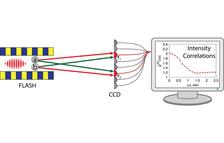Sketch of Hanbury Brown–Twiss interferometry performed at FLASH.
The recent advent of x-ray free-electron lasers (FELs) with their unprecedented peak brilliance and ultrashort pulse duration has a revolutionary impact on the development of the x-ray science and opened the route to a number of spectacular groundbreaking experiments including femtosecond nanocrystallography and single particle coherent imaging. However, the properties of FEL radiation are not yet fully understood, in particular, the statistical properties of FELs, which are based on self-amplified spontaneous emission (SASE). To explore this question two groups from DESY and the University of Hamburg/CFEL in collaboration with the FLASH team have performed a Hanbury Brown – Twiss (HBT) interferometry experiment at FLASH.
Hanbury Brown and Twiss, in their pioneering experiments, demonstrated that fundamental information on the statistics of light sources can be achieved by measuring intensity correlations at two separated spatial positions. Originally designed as a robust method to determine the size of stars, these experiments initiated developments in the field of quantum optics. In this work measurements of second- and higher-order intensity correlation functions were performed at FLASH by implementing HBT interferometry.
A high degree of the transverse coherence of about 80%, degeneracy parameter of the order 109 and an average pulse duration below 50 fs of the FLASH beam was demonstrated in this experiment. Such values are similar to laser sources and were never observed at these wavelengths at conventional synchrotron radiation sources. However, the measurements of the higher-order correlation functions indicate that present FEL sources based on the SASE principle are essentially chaotic sources obeying Gaussian statistics.
An interesting further application of the methods developed in this work would be the study of seeded FEL sources. An intriguing question is whether seeded FELs are fully coherent sources in all orders according to Glauber and, in this way, are equivalent to conventional single mode lasers, or if they obey Gaussian statistics like SASE FELs.
The intensity correlation analysis methods developed in this work might be applied in future to study the dynamics of ultrafast processes at FELs. For example, the intensity correlation analysis of the Coulomb explosion in single molecule imaging experiments could provide detailed information about the disintegration of these molecules on a femtosecond time scale.
(from authors)
A. Singer, U. Lorenz, F. Sorgenfrei, N. Gerasimova, J. Gulden, O.M. Yefanov, R.P. Kurta, A. Shabalin, R. Dronyak, R. Treusch, V. Kocharyan, E. Weckert, W. Wurth, and I. A. Vartanyants, Hanbury Brown–Twiss Interferometry at a Free-Electron Laser, Phys. Rev. Lett. 111, 034802 (2013). DOI: 10.1103/PhysRevLett.111.034802







